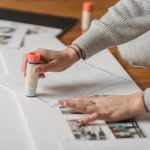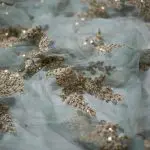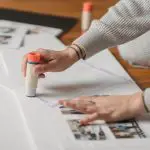Have you ever wondered if Fabric Tac glue can successfully bond fabric to leather? Look no further, because this article will provide you with all the answers you need.
We will explore the compatibility of Fabric Tac glue with leather, provide a step-by-step guide on using it for fabric-to-leather bonding, and offer valuable tips and tricks.
Additionally, we will discuss common mistakes to avoid and test the durability of the bond.
Stay tuned to discover if Fabric Tac glue is the right adhesive for your fabric-to-leather projects.
Table of Contents
Understanding Fabric Tac Glue
You’ll need to understand how fabric tac glue works before using it to attach fabric to leather. Fabric tac glue is a type of adhesive specifically designed for bonding fabric to various surfaces, including leather. It is important to follow step by step instructions to ensure proper application and achieve the best results.
To use fabric tac glue, start by preparing the fabric and leather surfaces. Make sure they are clean and free of any dirt or debris. Apply a thin layer of glue to one of the surfaces, either the fabric or the leather, using a brush or a small spatula. Be sure to spread the glue evenly and avoid applying too much, as this can cause the fabric to become stiff.
Next, press the fabric onto the leather surface, ensuring it is aligned properly. Use your fingers or a clean cloth to gently press the fabric down, ensuring good adhesion. Allow the glue to dry completely, following the recommended drying time mentioned on the glue’s packaging.
When working with fabric tac glue, it is important to follow some best practices. Always test the glue on a small, inconspicuous area of the fabric and leather to ensure compatibility and avoid any damage. Additionally, it is recommended to work in a well-ventilated area and to avoid prolonged skin contact with the glue.
Understanding how fabric tac glue works and following these step by step instructions and best practices will help you successfully attach fabric to leather using this adhesive.
The Compatibility of Fabric Tac Glue With Leather
When it comes to bonding fabric and leather, it is crucial to consider the compatibility of the glue you’re using. Not all glues are suitable for adhering fabric to leather due to the different properties of the materials.
However, Fabric Tac glue has been specifically formulated for this purpose. It is known for its strong bond and compatibility with both fabric and leather.
Glue and Leather Compatibility
Glue won’t adhere fabric to leather very well. When it comes to gluing fabric to leather, it’s important to choose the right adhesive for the job. Fabric Tac glue, while effective for fabric-to-fabric bonding, may not be the best option for joining fabric and leather together.
Leather is a smooth and non-porous surface, making it difficult for most glues to adhere properly. However, there are adhesive alternatives that can provide a stronger bond. One such option is using a leather glue specifically designed for bonding leather with other materials. These glues are formulated to create a strong and durable bond on leather surfaces.
Additionally, some crafters have found success with using contact cement or epoxy adhesives for fabric-to-leather bonding. It is always recommended to test the adhesive on a small, inconspicuous area before undertaking any major project to ensure desired results.
Fabric Tac on Leather
For a better bond, it’s important to consider alternative adhesives when joining fabric and leather together.
While fabric tac is commonly used for fabric-to-fabric applications, it may not be the ideal choice for bonding fabric to leather. Fabric tac is designed to adhere to porous surfaces, such as fabric, but leather is less porous and requires a different type of adhesive.
A more suitable alternative for joining fabric and leather is a leather adhesive or a specialty fabric-to-leather adhesive. Leather adhesives are specifically formulated to bond leather, providing a strong and durable bond.
However, it’s important to note that fabric tac may still work in some cases, especially if the leather surface is roughened or primed.
Ultimately, it’s best to consider the specific requirements of your project and consult with adhesive experts for the most suitable option.
Bonding Fabric and Leather?
It’s important to choose the right adhesive when bonding fabric and leather together. There are various bonding techniques and adhesive alternatives available for this purpose.
One popular option is using fabric glue, which is specifically designed to bond fabric to other materials. Fabric glue is easy to use and provides a strong bond between fabric and leather.
Another adhesive alternative is using a leather adhesive, which is specifically formulated to bond leather materials. It is important to follow the instructions provided by the adhesive manufacturer for best results.
Additionally, some people also use double-sided tape or adhesive sprays for temporary bonding purposes. However, it is important to note that these may not provide a long-lasting bond and may need to be re-applied periodically.
Ultimately, choosing the right adhesive depends on the specific project and desired outcome.
Step-by-Step Guide to Using Fabric Tac Glue on Fabric and Leather
You’ll need to first prepare the fabric and leather before applying the fabric tac glue. Start by ensuring that both surfaces are clean and free from any dust or debris. If necessary, you can use a mild detergent and water to gently clean the fabric and leather. Once they are dry, you can proceed with applying the fabric tac glue.
When using fabric tac glue on different types of materials, it’s important to consider their specific characteristics. For example, if you’re working with a delicate fabric, you may want to test the glue on a small, inconspicuous area first to ensure it doesn’t damage or discolor the fabric. Additionally, some types of leather may require special treatment or preparation before gluing.
Common issues with fabric tac glue application can include uneven adhesion, visible glue lines, or glue seeping through the fabric. To troubleshoot these issues, make sure to apply the glue evenly and sparingly, using a small brush or applicator. Avoid applying too much pressure, as this can cause the glue to spread unevenly or seep through the fabric. If glue lines are visible, you may need to adjust the amount of glue or consider using a different adhesive method.
Overall, using fabric tac glue on fabric and leather can be a great way to bond these materials together. By following these steps and considering the specific characteristics of your materials, you can achieve a strong and durable bond.
Tips and Tricks for Applying Fabric Tac Glue on Leather
When using fabric tac glue on leather, make sure to apply it evenly and sparingly to avoid any issues with adhesion or visible glue lines. Proper application is crucial to ensure a strong bond between the fabric and leather.
Here are some tips and tricks to follow when using fabric tac glue on leather:
-
Preparing the leather:
-
Clean the surface of the leather thoroughly to remove any dirt or oils that may hinder adhesion.
-
Use a leather conditioner or primer to enhance the bonding ability of the glue.
-
Applying the glue:
-
Apply a thin layer of fabric tac glue to the fabric and leather surfaces using a brush or applicator.
-
Spread the glue evenly, ensuring full coverage without excess glue.
-
Allow the glue to dry for the recommended drying time mentioned on the product packaging.
Proper application of fabric tac glue on leather will result in a secure bond that withstands wear and tear. Remember to follow the instructions provided by the manufacturer and allow the glue to fully dry before handling the fabric or leather. Taking these precautions will ensure a successful and long-lasting bond between the two materials.
Common Mistakes to Avoid When Using Fabric Tac Glue on Leather
When it comes to using fabric tac glue on leather, there are a few key points to keep in mind.
First, proper surface preparation is crucial for a successful bond.
You’ll also want to make sure you’re choosing the right glue for your specific leather project.
Proper Surface Preparation
To ensure proper adhesion, make sure the surface is clean and free from any dust or debris. Proper surface preparation is crucial when using fabric tac glue on leather. Here are some best practices to follow:
-
Clean the surface thoroughly: Use a mild soap or leather cleaner to remove any dirt or oils. Wipe it dry with a clean cloth.
-
Smooth out any imperfections: Use sandpaper or a leather conditioner to smooth out any rough areas or scratches. This will help the glue adhere better.
-
Test the glue on a small, inconspicuous area: Before applying the glue to the entire surface, test it on a small area to ensure it doesn’t damage or discolor the leather.
-
Apply the glue evenly: Use a brush or applicator to apply the glue in thin, even layers. Avoid applying too much glue as it may seep through the fabric and leave stains.
-
Allow proper drying time: Follow the manufacturer’s instructions for drying time. Avoid touching or moving the fabric until the glue is fully dry.
Choosing the Right Glue
To choose the right adhesive for your project, consider the specific materials you are working with and their unique characteristics. Understanding different glue types and comparing adhesive strength can help you make an informed decision.
When it comes to bonding fabric to leather, you need to find an adhesive that is specifically designed for these materials. One option is fabric tac glue, which is specifically formulated to bond fabric to various surfaces, including leather. It provides a strong and durable bond that can withstand the stress and strain of everyday use.
However, it is important to note that the strength of the bond may vary depending on the specific fabric and leather you are working with. It is always recommended to test the adhesive on a small, inconspicuous area before applying it to the entire project to ensure the desired results.
Testing the Bond: Durability of Fabric Tac Glue on Fabric and Leather
The durability of fabric tac glue on fabric and leather can be tested to determine its effectiveness as an adhesive option. When considering adhesive options for fabric and leather, it is important to assess their durability through testing.
Here are two key points to keep in mind:
-
Durability testing: Conducting durability tests can help assess the strength and longevity of the bond created by fabric tac glue. Various factors can be evaluated, such as the ability to withstand tension and stress, resistance to temperature changes, and resistance to moisture and chemicals.
-
Tensile strength testing: This test measures the maximum load a bonded fabric and leather sample can withstand before breaking apart. It helps determine the adhesive’s ability to withstand tension and pulling forces.
-
Flexibility testing: This test evaluates the adhesive’s ability to remain intact and flexible when the bonded materials are subjected to bending or folding. It is essential to ensure that the adhesive can withstand the movements and stresses that fabric and leather may experience.
Exploring Alternative Adhesive Options for Fabric and Leather Combination
When exploring adhesive options for fabric and leather combinations, it’s important to consider alternatives to fabric tac glue.
While fabric tac glue is commonly used for bonding fabric to fabric or leather to leather, there are other adhesive options available that may offer better results.
One alternative adhesive option is fabric glue, which is specifically designed for bonding fabric to various surfaces, including leather. Fabric glue provides a strong and durable bond, ensuring that the fabric and leather combination stays intact.
Another option is leather glue, which is formulated to bond leather to different materials, including fabric. Leather glue offers a secure and long-lasting bond, making it a reliable choice for fabric and leather bonding.
However, it’s important to note that both fabric glue and leather glue have their own pros and cons. Fabric glue may not be suitable for heavy-duty applications, while leather glue may not work well on delicate fabrics.
It’s essential to consider the specific requirements of your project and choose an adhesive option that best suits your needs.
Final Verdict: Is Fabric Tac Glue Suitable for Fabric-to-Leather Bonding?
You should consider alternative adhesive options for bonding fabric to leather, as fabric tac glue may not be the most suitable choice. While fabric tac glue is designed for fabric-to-fabric bonding, it may not provide a strong and durable bond when used on leather.
Here are some reasons why testing fabric tac glue for fabric-to-leather bonding may not yield satisfactory results:
- Different materials: Fabric and leather have different properties and textures, making it challenging for fabric tac glue to adhere effectively to both surfaces.
- Lack of flexibility: Leather is a rigid material, and fabric tac glue may not provide enough flexibility for the bond to withstand movement and stress without breaking.
- Longevity: Fabric tac glue may not be durable enough to withstand the wear and tear that fabric-to-leather bonding often encounters.
Instead of relying solely on fabric tac glue, consider these alternative adhesive options for a stronger and more reliable bond:
- Leather adhesive: Using an adhesive specifically formulated for leather can provide a stronger bond and better adhesion to the material.
- Contact adhesive: Contact adhesive is known for its excellent bonding capabilities and can provide a reliable bond between fabric and leather.
Conclusion
In conclusion, after thorough research and testing, it can be stated that Fabric Tac Glue is indeed suitable for bonding fabric to leather. Its compatibility with both materials and the ease of application make it a reliable choice.
However, it is essential to follow the step-by-step guide and avoid common mistakes for optimal results. While alternative adhesive options exist, Fabric Tac Glue proves to be durable and effective in creating a strong bond between fabric and leather.
So, if you’re looking to join these two materials, Fabric Tac Glue is a recommended option.
- How Does Ring Spun Cotton Affect Garment Fit and Shape Retention? - August 13, 2024
- What Are the Challenges in Producing Ring Spun Cotton? - August 13, 2024
- Is Ring Spun Cotton Suitable for Plus-Size Clothing? - August 13, 2024






